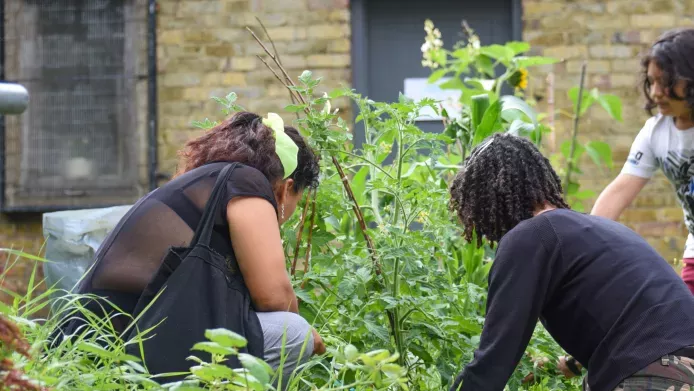2021 was a challenging year for young people and communities alike, so we wanted to acknowledge the amazing work they've done, against all odds.
On 16th September, we teamed up with our partner 70 St.Mary Axe to launch an exhibition showcasing our Creative Youth Project and Community Project grant recipients from 2020 and 2021, and all the great work they've done to transform community spaces, connect people and bring UK native plants and fungi to life through inspiring art and projects.
Meet the artists
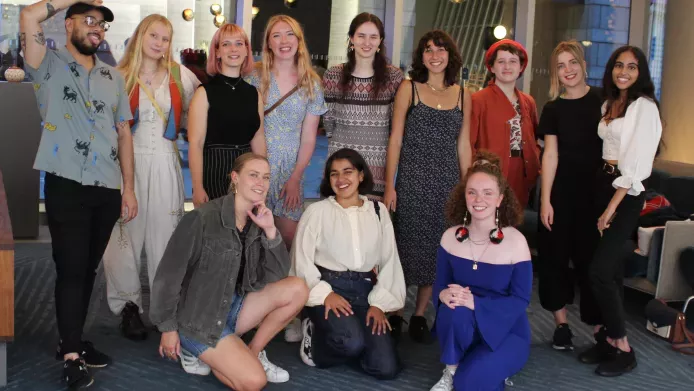
Our amazing 18-25-year-old London-based artists worked so hard, despite the challenges of the COVID-19 pandemic, to put together their UK-native plant and fungi-inspired creations. In Meet the artists you can read about these fantastic emerging artists, view their final pieces and learn about the concepts that inspired them...
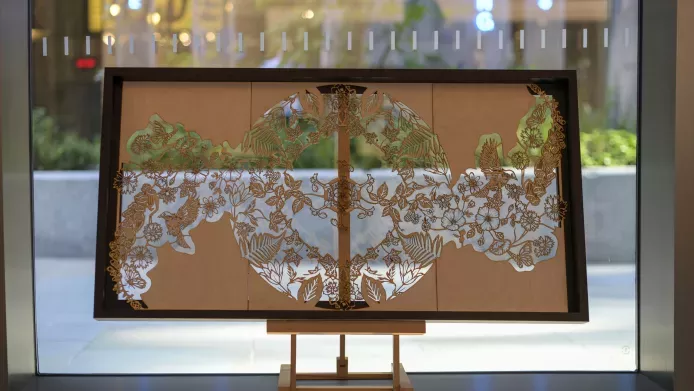
She/her:
Supported by the University of Warwick
Amanpreet is a London-based artist and biochemistry graduate from the University of Warwick. She draws inspiration from music, personal experiences and the natural world which she explores through paintings, illustrations and laser-based installations.
In Bloom
In Bloom represents the seasonal growth of UK native plants. Composed from laser-cut birch wood, the work intertwines and overlaps ten different wildflower species, incorporating bees, birds and butterflies. The journey begins at the core of the structure, with the seed. Seeds can sit dormant for years before the right conditions enable them to burst into life and growth can begin. Encircling the core; ivy, ferns and harebells bloom and bring beauty to dreary autumn and winter days. The blooming of wildflowers, which break away from this circle, represents the beauty of explosive blossoming that occurs in spring and summer. In Bloom encapsulates the journey of growth, from autumn to summer, when everything truly comes to life.
View PDF
Watch the animation:
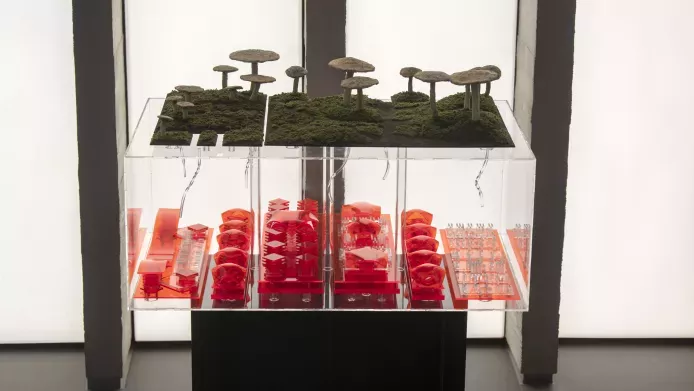
He/Him @Bijoy.jpg:Supported by Queen Mary University of London
Finding a passion for art as a teen, Bijoy has explored many different media, including painting, glasswork and sculpture. Graduating as an Engineer, he has continued to explore his connection with his artistic childhood. He finds himself most drawn to mixed-media art - sculptures and installations that show an active use of their materials and environment, playing with light, sound or motion.
Nature's Internet
Nature’s Internet explores the scientific research that is expanding our knowledge of the wildly complex lives of fungi. What you see (or eat!) of a mushroom is the fruit or the flower. The organism exists under the ground, as a network of fine threads called Mycelium. These “threads” are the creators of the fastest and most complex biochemical signalling network on the planet. Mycelium can form signalling networks across many kilometres using biochemical interactions that not only communicate to each other but also act as a signalling web for other nearby species. When you walk through a field of mushrooms, they all know you are there – they tell each other. They tell the surrounding plants too, and it has even been found that different species of plants will warn each other of insects or disease using this mycelial network, dubbing it Natures Internet. Over the last few decades, we have started to understand the sheer scale and complexity of their operation, but are still not fully sure how it all works.
In this project, Bijoy highlights and celebrates this remarkable process. Fungi are humble in their appearance and are perhaps even humbler in our minds - their most amazing work is done invisibly while they remain static, perhaps even ugly, to us. Would we give them the recognition they deserved if we could visualise their computational power in a way that was more obvious? Nature’s Internet aims to juxtapose the seemingly quiet, simple life of the mushroom with the highly complicated biochemical signalling that is going on under the soil. The Mycelial server room in this box is his representation of these processes, an attempt to describe their complexity in the way we think of these concepts: glowing lights, machined edges and technical components. Bijoy uses fluorescent acrylic to convey this - its smooth, adaptive glow is a stark contrast to the matte grey-beige flesh of the fungi itself.

She/her @emmacoleart: Supported by Wimbledon College of Arts
Emma is a London-based artist inspired by wildlife and natural habitats. She creates figurative sculptures combined with natural forms, exploring the relationship between people and wild spaces. Emma graduated from Wimbledon College of Arts in 2020, where she studied Production Arts for Screen. She learnt to work with a variety of materials and processes and is now developing more sustainable ways of working. She spent much of her final year in lockdown creating her sculpture Dryad which explores woodland habitats. This project inspired her to look into lesser-known but essential organisms found within these habitats.
Elfcup
Elfcup combines Emma’s study of the human figure with different British fungi. Her focus is on the importance of preserving and re-establishing habitats and connecting people to the natural environment. Emma has developed an interest in the vast variety of species present and has discovered some of the strange and lesser-known fungi. She has also researched some of the innovative ways that people are using fungi as a sustainable material: constructing furniture, bricks, and small buildings as well as an alternative to plastic packaging, fabric and ‘leather’.
Elfcup represents the diversity of mushrooms that Emma discovered. Selecting vibrant colours and unusual shapes, her piece is based on real species which look exotic and fantastical. Elfcup is made with air-drying clays, followed by layers of paints and varnishes. The name is derived from a small cup fungus that features on the sculpture. Emma wants to share her view of the natural world as both beautiful and fascinating, encourage people to explore their local habitats, and promote the value of conserving habitats in the UK and beyond.
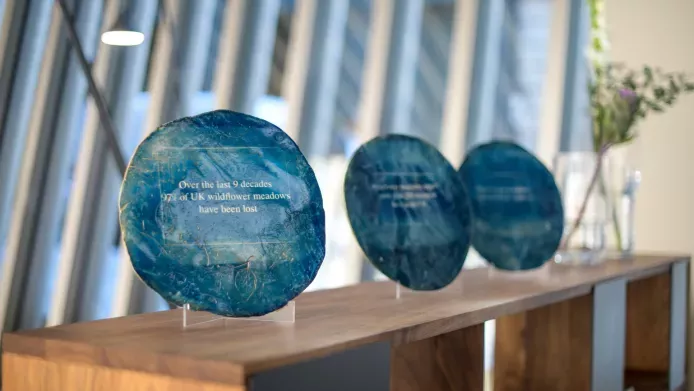
She/her @eva_maree_art: Supported by Central Saint Martins
Studying at Central Saint Martins, Eva is a maker of experimental photographs, machines and cameras. She is interested in redefining, altering histories and questioning the agenda and function of domestic objects, she is also interested in the problematic origins of photography. Using recontextualisation and reconstruction, she makes mechanical drawings, experimenting with unexplored elements of analogue image making, building her own cameras from found materials and altering the function of domestic objects to test their tensile strength. By using these technical skills, she creates objects and drawings that communicate lateral ideas using linear languages.
Untitled
Eva’s initial idea involved sunlight, a negative and a UK leaf to create a chlorophyll print. Building a camera from recycled wood to make the negative, she wanted to exploit the time-consuming nature of shooting film to express our need to slow down, something that we have been forced to do by the pandemic. Ironically, she ended up being stranded overseas and had to rethink her project. The images were captured during this time and aim to function as windows to the natural world. She explored the disconnect from our regular lives, which encouraged us to appreciate nature more.
Using white clay and cyanotype (a UV photographic print process) she made 3 negatives of natural spaces that have been essential to her during COVID-19. The circular shape can be likened to a clock, reminding the viewer of the significance of time in the protection of nature. The embossed surface was created by rolling a selection of plant life into it. Cyanotype, unlike many alternative processes, is developed using water and therefore more environmentally friendly- an important factor in the creation of her work. By using both clay and cyanotype she has explored more environmentally friendly images of image-making.

She/her @artyfacegrace: Supported by Create London
Having completed a Foundation Art course at UAL, Grace is exploring her role as a Christian and an artist. She draws great inspiration from the Bible; the imagery it uses to convey important messages influences her to do the same. She creates outlandish and often comedic costumes, sculptures, drawings and films, layered with meaning, and through them explores her religion and the world around her. She gravitates towards using accessible, recycled materials, like cardboard and papier-mache. Grace plans to continue to explore different art forms as she furthers her studies at Camberwell College of Arts, using the natural world as a source of both inspiration and material for her work.
Growing Ginormous
Exploring the theme of personal growth, and the growth of the plants and fungi around us, Grace has explored how they allow us to flourish. She created tree-trousers, representing the unrealistic growth imagined as a child. The trousers becoming a symbol for both the personal growth and literal growth we experience as humans.
Collaborating with people from different ages, backgrounds and opinions, and with nature itself, she worked with other contributors, who created drawings of plants, trees and fungi; the results of this collaboration adorn the trousers, creating a community upon them.
Due to the circumstances over the past year and the inability to physically interact, Grace created an online space where people submitted pictures of their creations, and these were then translated onto the trousers. The trousers are made from recycled paper, cardboard and willow; trees from trees.

She/her @honeymounce: Supported by Walworth Garden
A Fine Art graduate from Chelsea College UAL, Honey works mainly in sculpture. She draws a lot of her inspiration from biomorphic forms and enjoys looking at and exploring mundane and often overlooked situations, feelings and objects.
Cluster
Taking inspiration from the way certain fungi form on their own and as a group, Honey focussed on these clusters’ forms. Exploring how they seem to ooze around one another, stacking up into doughy piles, she also enjoyed looking at the smaller details; the way that the gills layer up, and the arching structures of the cups and umbrella tops. She studied fungi local to her, the ones that were squished into corners, creeping along tree trunks and hidden in the grass. Her hope is that by isolating these visual features and blowing them up into a blobby arch, she will highlight the beauty of these often-overlooked organisms, transforming them from something that is slightly ridiculous and alien in appearance.
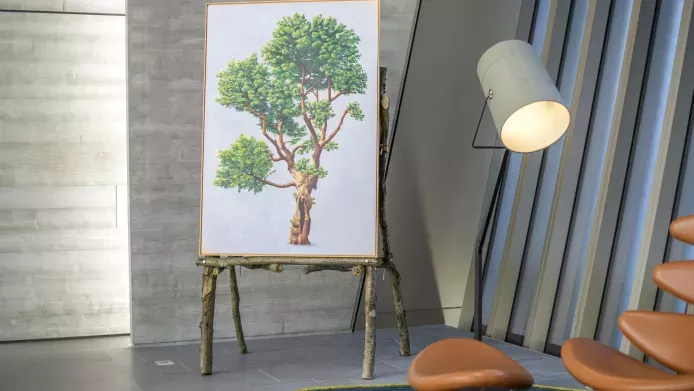
She/her @hoggmakesall: Supported by the South London Botanical Institute
An artist and Designer with a background in environmental studies and sustainability, Isabelle is a lifelong birdwatcher and hobby botanist, educated in environmental biology at Lancaster University. Growing up in England, Scotland, Brunei and Nigeria, she learnt about organisms and ecosystems around the world. She is a self-taught artist and enjoys creating illustrations and models inspired by nature. Inspiration for this piece came from the book Wilding by Isabella Tree, her modules in native ecosystems at university and the beautiful oak trees at her parent’s house in Sussex.
One tree, a thousand homes
Isabelle has explored the role of Oak trees in the ecosystems of the UK; they support some 2300 species of plants and animals, 326 of which are completely dependent on oaks as their sole home. They have complex connections and interactions with each other and the wider landscape; each tree holds more value to the world than we give them credit for, even in cities. Isabelle hopes her work encourages people to look more closely at the trees they walk past each day, to wonder at the vast amounts of life they support and to appreciate their complexity and individuality.
She was keen to exhibit both the beauty of veteran oak trees and how impactful they are on native ecosystems. To do so, she chose to focus the viewer’s attention on just one tree by painting a botanical illustration in acrylic. Making the canvas out of wood and the easel out of coppiced hazel from her family’s garden in East Sussex.
The chosen tree is a veteran English Oak located in Camberwell New Cemetery in South London. She felt that it was important to pick a tree in the city to highlight how beautiful city trees can be. After research, she ultimately found this hollowed oak through a wonderful blog written by Daniel Greenwood called Oaks of London. The work is both colourful and anatomically realistic. Each of the small dots around the tree represents one of the 555 species that wouldn’t survive without English oaks, including invertebrates, birds, mammals and fungi.

She/her @kinga.pilart: Supported by Poplar Union
Born in Poland, artist Kinga Pilarska was raised in London. Through her work, she comments on the philosophy of being and how we came to be where we are now. She explores issues that are important to her, specifically housing, sustainability, our environment and cooperative living.
The Ground Gives
Creating fungi forms painted in bright colours, Kinga has created fungi that are out of scale in relation to each other and to us. She has exaggerated the scale of some more than others, to encourage a reading of the pieces as individuals as well as a collective. Through the choice of bright colours, she has referenced wildflowers growing within the UK. Kinga wanted to mesh together fungi and flowers, using bright colours to draw more attention to the fungi forms.
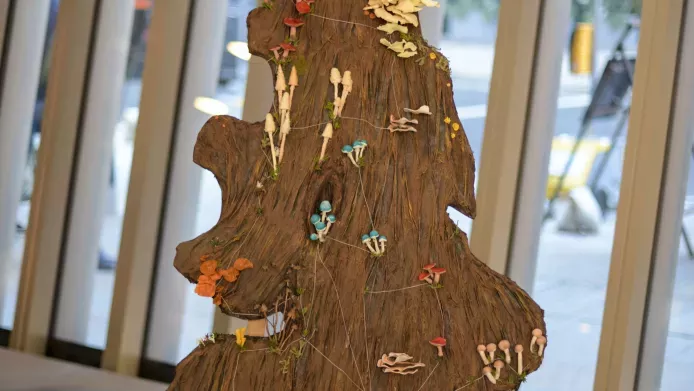
He/him: Supported by the University of Warwick
Luca studies Biological Sciences at the University of Warwick. He is inspired by life sciences, specifically sustainable agriculture and the protection of the ecosystem. Through The United Kingdom of Fungi, his first formal art project, he has explored his inspiration creatively.
The United Kingdom of Fungi
The United Kingdom of Fungi includes a variety of fungi native to the UK placed at the sites of the major urban areas, to represent their supportive potential along with an under-laying network of mycelium, dubbed the “wood wide web”. Represented in the form of the national railway service they reflect how the two are analogous - in that they are crucial in many ways for the survival of the UK and its ecosystems, and essential for the transport of information and efficiency.
Luca’s work encapsulates how fungi have the capability to support many aspects of our lives; from revolutionising the way we manage our ecosystems to waste refinement within the sector of biorefinery in Britain’s urban areas, all of which lead the UK to become a more sustainable nation. Luca has explored ideas initially introduced to him by Mycologist Paul Stamets, through his Ted talk and book Mycelium Running.

She/her @lush.artwork: Supported by the Bee Friendly Trust
A self-taught artist, whose work focuses on personal stories - experiences, environments and people that inform who we are. Lucie is intrigued by colour and texture and is working to create connections between inspiration and application. As a strong environmentalist, her love of nature has been crucial in informing her identity and drives her to promote sustainable living.
Nostalgia
Through her work, Lucie explores the idea that our first experience of plant life occurs in childhood and that many people associate their exploration of nature with the freedom and innocence of this time. She draws on these primal and deeply rooted associations in Nostalgia which is created to remind the observer of the importance of our human connections to plants. Explorations of childhood memories are intertwined with individual interpretations of flowers alongside bottled aromas. Aromas are highly evocative and closely linked to memory which is particularly relevant in our fast-paced concrete surroundings, these often obscure our memories of freedom and innocence. Working with the Bee Friendly Trust to select native flowers which support the UK’s bee population this piece promotes the ecological importance of native flowers while enabling the rediscovery of our personal connections to nature.

She/her @greenheartpottery: Supported by Putney School of Art
A Welsh Ceramicist based in South West London and founder of Greenheart Pottery, Lucy has a background in Product & Furniture Design and is driven by exploring our connections to place and nature through making. As an emerging ceramics artist, she is practising different industrial and handmade processes such as wheel-throwing, mould-making and slip-casting. Lucy is excited by sharing and preserving skills that bring us closer together and teach us about our heritage and identity. She believes craftsmanship offers an important platform for reflecting the beauty of nature and for promoting more sustainable practices.
Wetland Wildflowers
Lucy has created a collection of earthenware vessels, decorated with UK native plant life; Yellow Marsh Marigolds and Water Forget-me-nots. Her work focuses on the critical importance of wetlands within the UK’s natural ecosystem. For this project, she researched marginal plants which grow in marshes near open water. These areas of grasses, reeds and wildflowers are fantastic habitats for native birds, insects, mammals and amphibians. Providing a crucial haven for wildlife whilst also offering a verdant isle of peace and refuge from the hustle and bustle of city living.
Often making use of previously neglected or non-productive urban land, such centres support an ecosystem thriving in biodiversity. While wetlands represent 3% of the UK’s land coverage, they are home to a tenth of all wildlife species. Additionally, they are also crucial combatants in capturing carbon dioxide, with peat wetlands being able to store more carbon in their soil than rainforests.
She/her @leaf.sick: Supported by the South London Botanical Institute
Matilda is a mixed media artist from South London inspired by city life and the dualism between man-made and natural. Her work highlights how our vital co-dependency has been distorted by the values of an alienated consumer society.
Wild Side
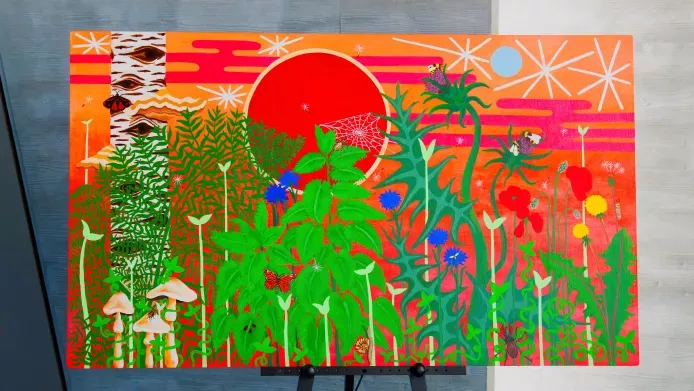
Wild Side explores the idea of escapism and the way we cope with the pressures of modern life. Through music, art, performance; cultural microcosms are created out of a necessity for communities to survive. For example, in the 90s when UK Garage erupted onto the underground scene, it met the need for marginalised youth to self-identify, build community and create legacy.
She explores the need for nature to be inclusive, questioning barriers to access in the city and exploring how lockdown restrictions have highlighted this. ‘Green spaces in London have historic relevance to the urban working class. In 1845 London’s very first park, Victoria Park, claimed to increase life expectancy of east Londoners by 3 years.’ In her borough of Lambeth, green space has decreased 20% per head in the last decade, and only a third of all residents have a garden of their own.
Green spaces are vital for us to slow down and connect to a meaning greater than ourselves, improving our mental, physical and spiritual health. Through semi-abstract styles, textures and fluorescence, Matilda aims to imitate aspects of the psychedelic experience. She hopes that her painting can act like a window for the public to be transported to a kind of otherworldly Utopia. ‘A place we want to be, but is just out of reach.’
Accompanying sound tracks:
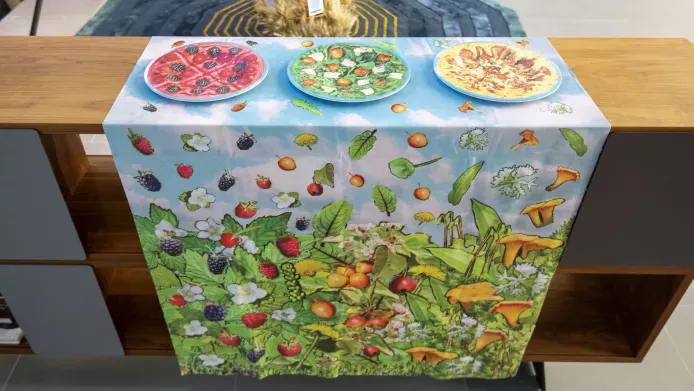
She/her @matleenahonkanen:Supported by Kingston Hub
Matleena is a Graphic Designer interested in exploring the connections between visual arts and design. She finds inspiration in bringing information to life through visualising it in playful and engaging ways and by pushing the boundaries of typography, photography and digital art. Originally from Finland, Matleena has always made nature a large part of her life, and it has influenced her artistic practice. She is studying Graphic Design at Kingston School of Art, and is curious about exploring the effects technology has on human discourses such as relationships, self-expression and politics. She primarily works with digital media but enjoys making prints and books.
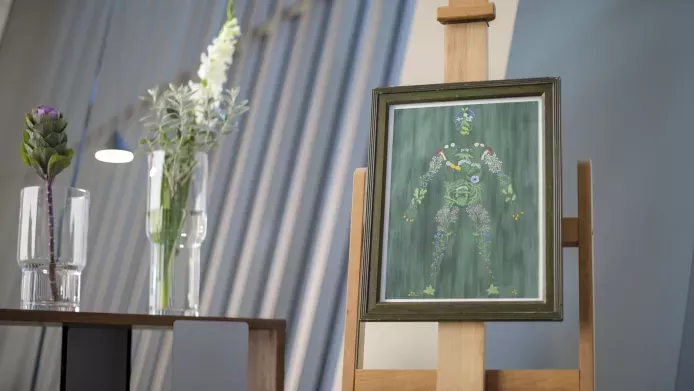
She/her @megmckenzie.art: Supported by Climate Museum UK
A biophilic artist, working in animation, film, textiles, wearable art, drama, embroidery, digital art and painting, Meg was born and raised in South East London and studied Visual Art at the BRIT School. Her art depicts visions or dream states from time spent in nature and feeds into her activism for climate justice and the wellbeing of the natural world. She hopes to create work that positively influences peoples’ approach to natural life and helps them to understand the intricate systems of interconnectivity between us and our Earth.
Inspired by the Celtic myth of Airmed, the goddess of healing and herbalism. Grieving from her brother’s murder by their jealous father, Airmed's tears watered the earth and all the healing herbs of the world grew where he lay. There were 365 herbs, one for each of his sinews and joints. As Airmed collected them, they spoke to teach her of their healing powers. She laid them out on her cloak to match the places of the body they can heal. When her father saw her work, he angrily flung the cloak, scattering the herbs. Because of this, no human knows all the secrets of healing herbs. From this tale, Meg has created a short hand-painted animated film (443 individual painted cells). This detailed process, created using her own stencils and a ruler, can take up to 10 hours to produce just one second of film. She has also created an interpreted oil painting of a figurine of flora, laid out from the UK’s native plants and fungi corresponding to their most effective healing body part. However, instead of 365 plants, she has depicted a select number, reduced to accommodate the lessened knowledge we have about the magic abilities of the greenery that surrounds us.
Watch the animation:
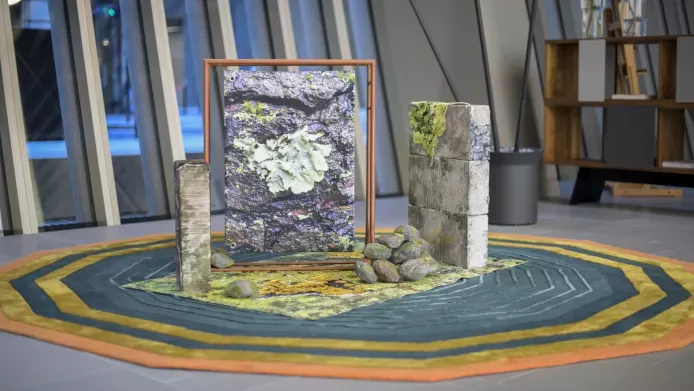
She/her: Supported by Seeds For Growth
Patricia is a mixed media artist, early years educator and art student at Manchester School of Art. She has an interest in urbanism and the natural world, the way these overlap, and the way nature and joy are experienced in the city.
Close Looking
The work is a sculpture and photography installation that displays examples of lichens found in cities and urban environments. Using materials that contrast common urban substrates with vibrant greens and yellows, Patricia shows us the beauty and mystery of lichens. Often hidden in plain sight, lichens are an integral but delicate part of the ecosystem and their health is a mirror to the health of our environment. Complex organisms, they are made up of a symbiotic partnership between fungi and bacteria and grow on a wide variety of natural and man-made materials. Patricia's intention in creating this artwork is to make unexpected connections and to enable others to experience the world differently. Lichens and their slow growth in grey spaces and patches of parkland- provide a route into this alternate view of the city, a meditative, slowing down - an interruption.

She/her @phoebesarahwagner: Supported by The Barbican Centre
Phoebe is a Poet, Theatre Maker and Facilitator from London, UK. She is an alum of Barbican Young Poets, Roundhouse Poetry Collective, Rose Bruford and The BRIT School. Her work is inspired by politics in the personal and community. She published her debut pamphlet The Body You're In with Bad Betty Press in 2019. Her work extends across community and arts organisations such as Omnibus Theatre, the National Literacy Trust, National Maritime Museum and the Poetry Takeaway. She runs Crep Project, an arts collective exploring trainer culture with young working-class people. They opened their first exhibition made by young people from Barking and Dagenham in collaboration with Studio 3 Arts in summer 2021.
We Are All Lichen
We Are All Lichen is a visual poem grown from an online mind-map. The title of the piece is inspired by the introductory quote from the essay Queer Theory for Lichens by David Griffiths. This visual poem is a collision of free associations, joining in a collective experience. The poem plays with word games, explores growing up and asks questions of its own individual identity. Lichens are the patches of colour that often grow on tree-trunks, bins, bricks and other surfaces. They're even able to survive in outer space. When ecologists began to study them more closely, they found them to be composed of more than one type of organism, sometimes algae and fungi, but many were difficult to categorise. These organisms live together, symbiotically, and make up a lichen. They share their resources in order to survive. David Griffiths' essay shows how 'we have never been individuals' and how lichen reproduction defies the heteronormative scientific assumption that straight sex is natural. The creative process began as an online growth on the mind-mapping tool Kinopio. Layered and collaged from her own research, free writing and mind-mapping, Phoebe used crowd-sourced questions to grow a poem that mirrors the microscopic structures of lichen. The questions grew through visiting contributions throughout the work's creation and onwards. The mind map continues to grow.
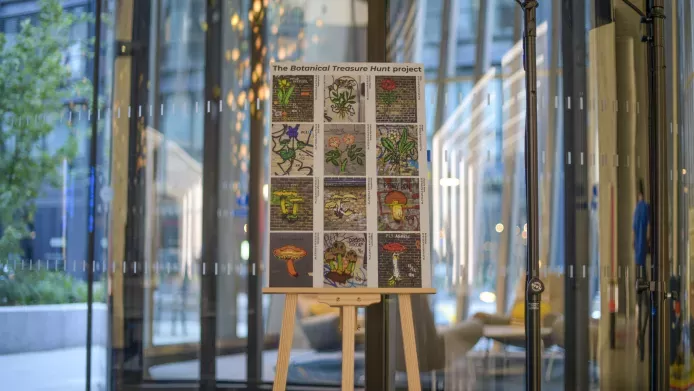
She/her @robin_mooneye: Supported by the Bromley By Bow Centre
Born in Genoa, Italy, in 1996, Robin studied art and design at Brera's fine art Academy in Milan. Getting a first glance into printmaking techniques; woodcut, lithography, etching and screen printing. In 2017 she continued her studies at Urbino's fine art Academy, refining her printmaking and digital skills and learn new ones such as publishing, bookbinding and illustration. With this knowledge she now designs, illustrates and builds books from scratch. After graduating with honours in 2019, she moved to London, where she works as a Creative Artworker for a videogame company and a freelance Illustrator and Graphic Designer.
The Botanical Treasure Hunt
A treasure hunt divided into twelve botanical illustrations of common British flowers and fungi, spread throughout East London in the Shoreditch/Bow area, all photographed and displayed on a foam board, together with every mural's map coordinates.
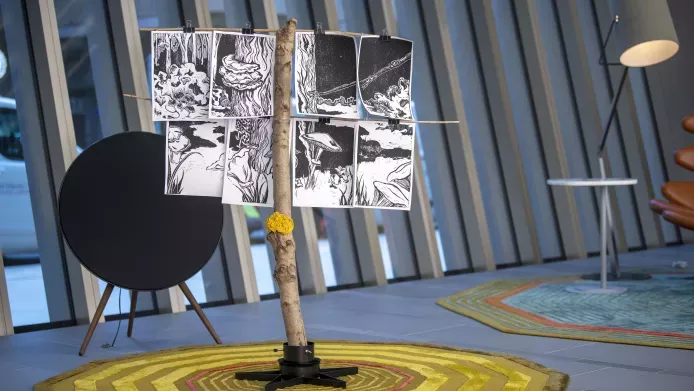
She/her @sneha_aoishi: Supported by The Barbican Centre
Sneha is a Painter, Writer, and Printmaker. She exhibited her first lino print installation at It All Comes Down (2020), as part of the Barbican Centre’s Young Visual Arts Group exhibition. After studying English Language and Literature at the University of Oxford, Sneha combined her passions for art and literature in an MA in Postcolonial Studies (SOAS, University of London) where she focused on queer and post-colonial interventions into the art world. She is inspired by nature and is interested in the politics of people of colour in rural spaces. Her work often investigates myths, dreams, and relationships to land.
Spore
Spore is a work in two parts: a physical lino print installation and an accompanying work exploring each print further through different media. The installation consists of a frame constructed from found objects hung with eight black-and-white prints. The prints depict a woodland glade that is home to a variety of fungi, with the installation designed so that the lino prints move with the slightest gusts of air.
The online artwork reflects the hidden interconnection of mushrooms; a hyphal network of artistic responses. The Chicken of the Woods fungus sparks a mini-essay, for example, while Scarlet Elf Cup evokes a short-form comic. In Spore, Sneha took pleasure in the way that disparate forms wind themselves together, not unlike the mutualism of mushrooms.
Before this project, the word “mushroom” was represented by the marbled white-and-green fuzz on a carelessly discarded piece of fruit, or the lurid red toadstools so loved by children’s picture books. During the research process (from the works of Anna Tsing, Merlin Sheldrake, and Robert Macfarlane) Sneha discovered that fungi were a species kingdom of their own and were the centre point for a growing number of socio-ecological and political bodies of work. A kingdom entirely separate from plants or animals, fungi cannot make their own food and rely on existing organic matter. For some fungi, this leads to symbiotic relationships; both the fungus and its food source benefit from the relationship. The joyous boundary-crossing of fungal lifeforms reminded her of artistic cross-pollination: spores of one idea morphing into another, creating new relationships and work.
Grow Wild would like to thank all the artists who took part in the exhibition and the organisations who supported them.
Community Projects

In 2021, five Community Projects from across London received a £1,000 grant to connect local city dwellers with the natural world or transform an urban space. From plant growing to willow workshops, herbal tea making to bringing a disused park entrance to life, our Community Project participants have created real impact and positive change in their communities. Read on to see some of their project highlights.
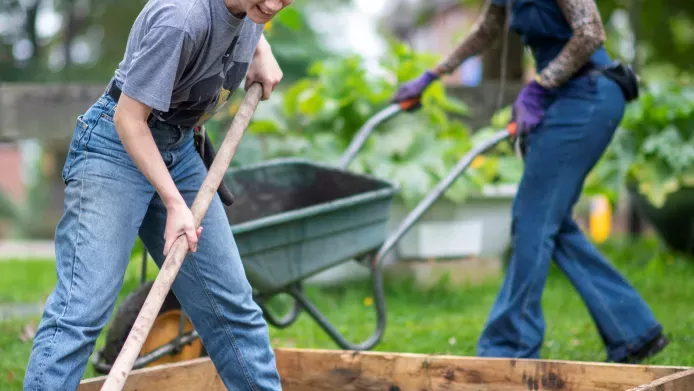
A grassroots, resident-led community garden for all, aiming to connect residents of the Denmark Hill Estate in South London through growing and creative workshops. Residents came together during lockdown and started making use of planting beds within their estate, creating a place for people to meet safely outdoors and grow. With their grant the group now has plans to expand the garden, adding new beds and a greenhouse.

Heath Hands works with people and groups of all backgrounds and abilities wanting to get involved in volunteering and recreation across green spaces. With their grant, the group has adopted an unloved spot close to an entrance of Hampstead Heath. They are working with young local volunteers to bring planting and artwork to the site, creating an inviting space full of colour, which will enhance local biodiversity.
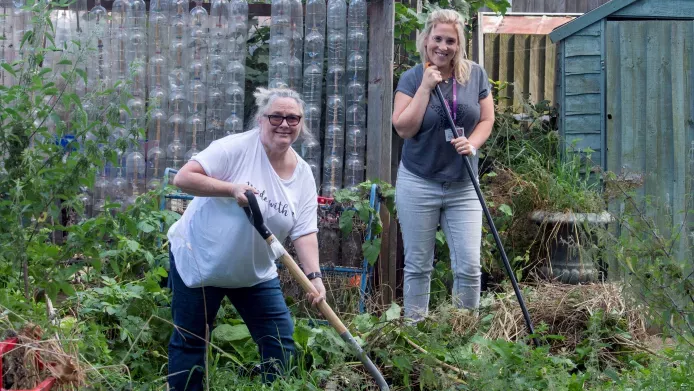
Buxton School is an all-through school in Leytonstone, London educating pupils aged 3 to 16. The school acquired an old allotment site from the council to develop as a much-needed green space for pupils to learn about the environment, conservation, gardening, science and to experience the natural world. The school is keen to establish the space as an outdoor classroom, whilst retaining wild areas and working with the pupils to enhance its biodiversity.
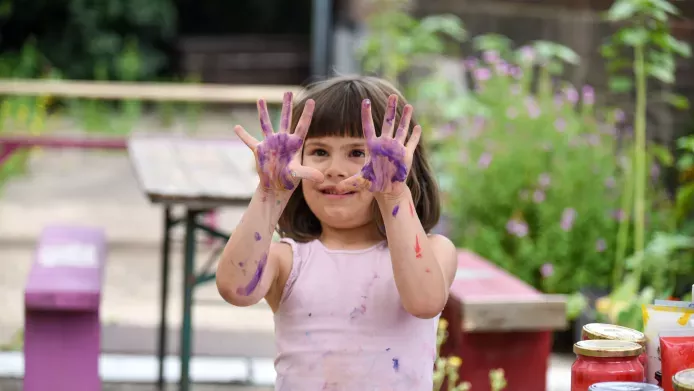
A community garden and eco-educational hub that raises awareness of empty spaces in the city, grows food for the local community and hosts interactive workshops. With their grant, the group is transforming an unused concrete space into a vibrant community garden. Young local volunteers have been working with two artists, Krista Vasilijeva and Olga Filatova to create an eye-catching mural that celebrates UK-native plants and fungi.
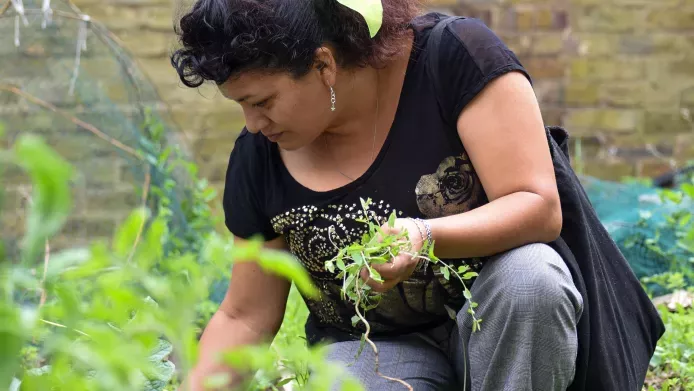
Cordwainers Grow is a Hackney-based community interest company focusing on connecting people with the natural world in creative and collaborative ways. Cordwainers Grow has been working in collaboration with The Round Chapel Families Project, together they've used their grant to work with local families and children to develop a community garden space at St Matthew’s Church in Hackney. They've also run workshops to help people learn about the uses of UK-native plants and how to grow them.
With special thanks to our project sponsor, 70 St. Mary Axe and our programme funder, the National Lottery Community Fund.

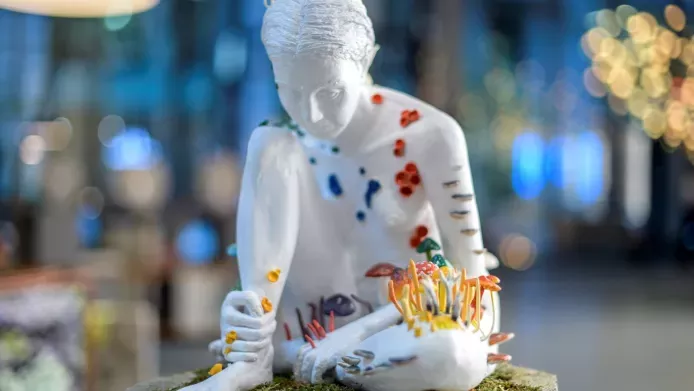
Previous projects
